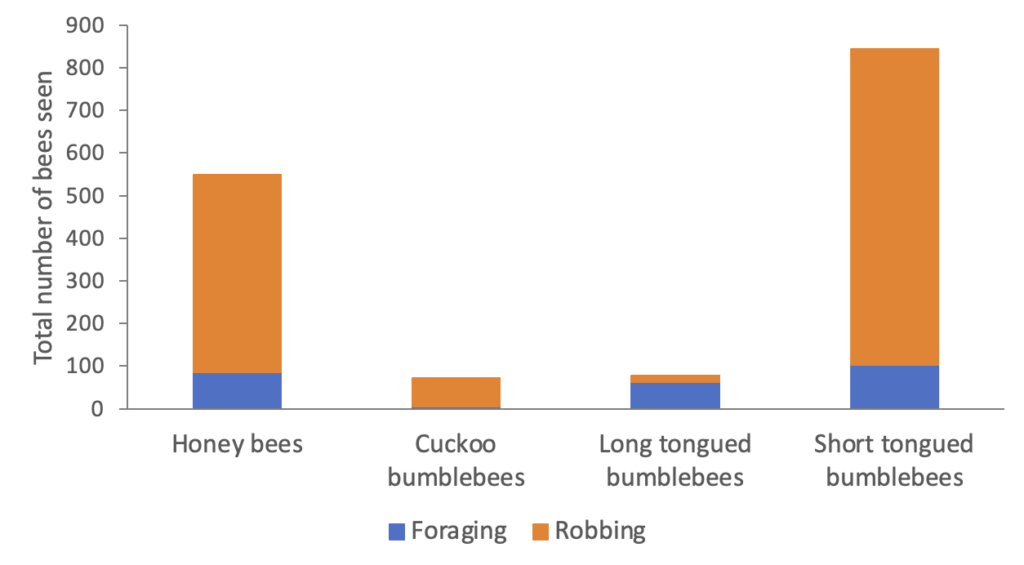The BEESPOKE project aims to reverse the decline of pollinators and increase crop pollination on farms in the North Sea Region. Currently the project partners are working to develop bespoke seed mixes and habitat management guidelines to support pollinators on a wide range of crop types.
In 2021, as part of this project, we carried out experiments to investigate how flower-rich areas around field bean crops affect crop pollination. We surveyed bees along transects and observed their behaviour, looking at whether they were foraging or robbing nectar from the bean flowers. Bees that forage enter the flower from the front, and in turn pollinate the flower when retrieving nectar. When they rob, they chew a hole at the back of the flower or use a hole made by another bee and they steal the nectar without pollinating the flower – a lot of people are unaware that bees even do this!

Note: see how there is already a hole present at the back of the flower? (Credit: Thomas Van Loo)
Some bee species forage more than others, this is likely down to their tongue length, which we know is linked to their behaviour. Some flowers are shallow and are easily accessed by all bees, but longer-tubed flowers are more suited to long-tongued bees. Bee species with long tongues include the garden bumblebee, common carder bumblebee and most cuckoo bees, and short-tongued species include the white-tailed and buff-tailed bumblebee and the honeybee.

So far, our results show that there were over 800 short-tongued bumblebee species counted across the farms, but less than 100 long-tongued bumblebees counted (Figure 2). The short-tongued bumblebees, specifically white and buff-tailed bumblebees and honeybees, carried out robbing behaviour much more frequently than foraging (Figure 3). There weren’t many cuckoo bumblebees present but we found that although cuckoos tend to have long tongues, they still rob most of the time. The long-tongued bumblebees – the garden bumblebee and common carder bumblebee – did forage more, but they were present in much lower numbers. Overall, we witnessed much more nectar robbing than foraging.

species of bee: the white/buff-tailed bumblebee and honeybee with shorter tongues, and the garden
and common carder bumblebee with longer tongues.
Other factors like temperature and cloud cover were also recorded to see if they influenced bee behaviour. Some trends were found – for instance, at the coldest temperature and when it was more overcast (above 80% cloud cover) there were a higher proportion of bees robbing. This is as expected, as when it’s colder and there is less sunshine, bees are slower and need to preserve their energy, so they opt to save energy by robbing flowers of their nectar. However, the trend becomes unclear as temperature increases and cloud cover decreases. Farm location and the presence of flower-rich habitats could be a factor that affects these trends.
Further exploration of our results and data collected by our BEESPOKE partners might provide more insight into the factors affecting bee behaviour. However, the initial results suggest that there is a much higher presence of short-tongued bees, which rob nectar more frequently than they forage and so may not pollinate the bean flowers as much.
The surrounding habitat will affect which species may be present in the area and how many. It might be possible to develop flower-rich habitat that specifically promotes longer-tongued bees, for example. This fits a key aim of the BEESPOKE project; by developing wildflower seed mixes made up of plants tailored to support specific pollinators and sowing these near to crops, it might be possible to improve crop pollination.

I noticed this behaviour about 5 years ago and thought it was the end of the world… I thought that the Bee’s had turned renegade. I borrowed a water pistol from the kid next door and began to patrol my beans, spraying any bees that wouldn’t play nice.. I became a veritable marksman… Since then I have observed this behaviour and believe the Buff Tail to be the main culprit and the one that bores the initial hole.. This year I had no bees at all in early June, then the White Tails among others showed up late June, early July. They were often checking the backs of the flowers but foraging as there were no holes present.. In the last week or so, the Buff Tails have turned up and it’s all gone to pot.. The first year I noticed it, the beans were planted late and the Buff Tails were the first on the scene. I still managed to harvest a reasonable crop and often, even beans that had been got at, still matured. Whether they had already been pollinated or not, I would guess so.